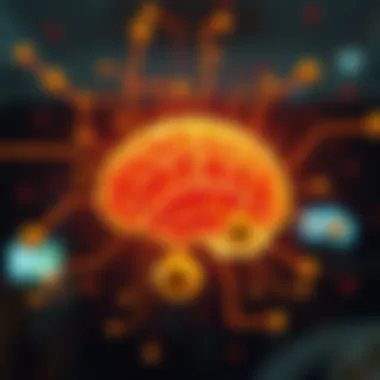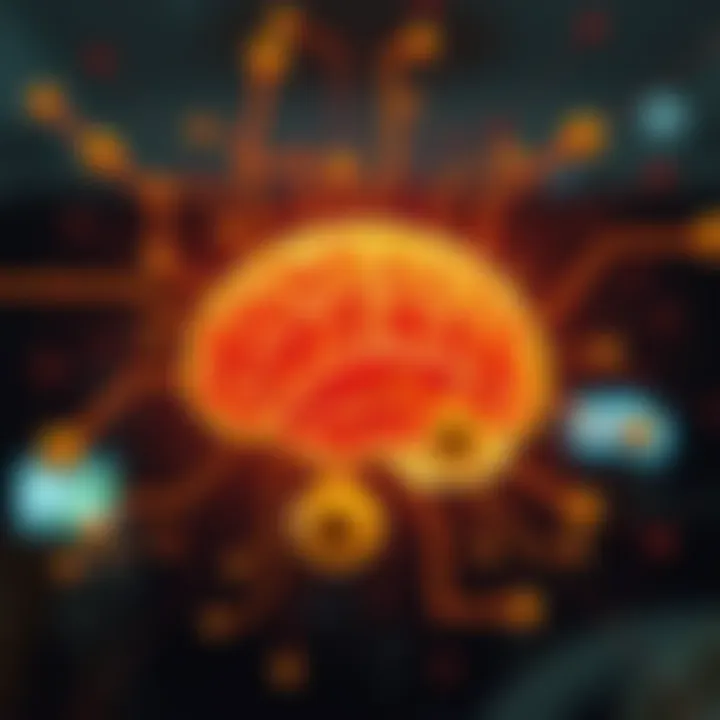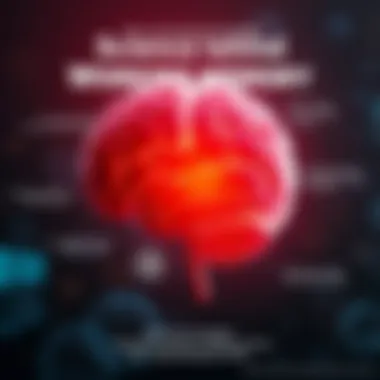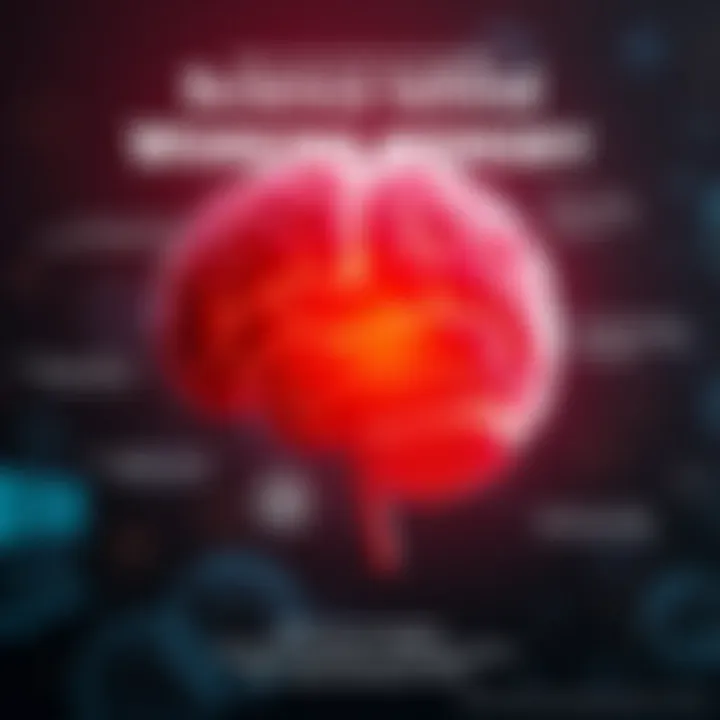Effective Strategies to Enhance Your Working Memory


Intro
Working memory is a critical function of our cognition, acting as the mental workspace that enables us to hold and manipulate information in real time. This is essential for tasks as mundane as following a recipe, to as complex as solving mathematical equations or engaging in meaningful dialogue. As technology and demands on our attention continuously grow, ensuring our working memory is as sharp as a tack is more important than ever.
Here, we delve into various strategies that can help bolster this essential cognitive ability. Understanding how working memory operates and recognizing the challenges people commonly face lays the foundation for exploring practical techniques aimed at enhancement.
Let’s explore how insights from cognitive science guide our approach to improving working memory and the relevance of these interventions in our daily personal and professional lives.
Understanding Working Memory
Understanding working memory is crucial as it serves as the backbone of our cognitive processes. This mental workspace enables us to hold and manipulate information temporarily. Why is this important? Well, think of working memory as the control center of our brain. Just as a pilot needs a cockpit to manage flight instruments, individuals must utilize working memory to navigate daily tasks and complex decisions.
Definition and Importance
Working memory can be defined as the ability to temporarily store and manage information necessary for complex cognitive tasks, such as learning, reasoning, and comprehension. It’s like a mental chalkboard, allowing us to jot down thoughts that we can refer back to later, but only for a short period. The importance of working memory cannot be overstated.
Cognitive Framework
Cognitive frameworks offer insight into how our minds process and manage information. Working memory fits snugly into this landscape, linking various cognitive functions. To truly appreciate its significance, one needs to delve deeper into the components and roles that structure it.
Components of Working Memory
The components of working memory include the central executive, phonological loop, visuo-spatial sketchpad, and episodic buffer. Each of these elements plays a distinct role in how we handle information. For instance, the central executive acts as the conductor of an orchestra, directing various memory components to work in harmony. It enables us to prioritize tasks and decide which information is relevant at any given moment.
A unique feature of these components is their interplay; while one part may focus on verbal information, another might tackle visual data. This multi-faceted approach allows individuals to function seamlessly in everyday tasks. Understanding these components informs strategies that can enhance working memory. The better we understand how these pieces fit together, the more effective our cognitive improvement strategies can be.
Role in Learning Processes
Working memory plays an indispensable role in learning processes. It facilitates the integration of new information with existing knowledge, fostering deeper comprehension. Consider a student trying to learn a new language; they need to retain vocabulary and grammar rules while simultaneously practicing speaking and listening. This juggling act relies heavily on a robust working memory.
What makes it particularly beneficial is how it influences a learner's ability to problem-solve and think critically. Students with stronger working memory often excel in analytical tasks. However, there are challenges as well. Learning can become overwhelming when individuals face high cognitive loads, which can overload working memory and hinder learning.
By recognizing the significant role working memory plays, educators and learners alike can adopt more effective study strategies. It’s not merely about memorizing; it’s applying and adapting knowledge in real-time.
In summary, understanding working memory unlocks pathways to enhance cognitive capabilities. It reveals the processes behind how we learn and remember, ultimately aiding in academic and professional success. For further exploration of cognitive factors, feel free to consult resources at Britannica or Wikipedia.
Common Challenges in Working Memory
Understanding the roadblocks that hinder working memory is a crucial step toward enhancing it. Identifying these limitations not only helps clarify the specific weaknesses that individuals may face but also empowers them to take corrective actions. Recognizing challenges allows for more targeted interventions and strategies, fostering an environment where cognitive capabilities can thrive.
Identifying Limitations
Short-Term Memory Decline
Short-term memory decline is a significant barrier to effective working memory function. This condition manifests as an inability to retain and quickly recall information over short spans. As people age or encounter excessive stress, they may find it increasingly difficult to manage daily tasks requiring quick thinking and retention. This topic is especially pertinent in discussions about cognitive health. Its relevance can't be underestimated, as short-term memory decline can dramatically affect learning and task performance.
The key characteristic of this decline is that it does not equally impact everyone. Factors like mental fatigue, anxiety, or even sleep deprivation can exacerbate the issue. For instance, a student trying to memorize information for an exam may struggle more if they're sleep-deprived. On the flip side, understanding one's limitations can pave the way for employing specific memory enhancement strategies. By recognizing that short-term memory is not immutable, individuals may be more inclined to explore self-improvement techniques.
A unique aspect of this decline is its interplay with emotional states. When an individual is stressed or anxious, their capacity for short-term memory can erode. This cyclical effect raises a crucial point: addressing emotional health can improve memory function, thus, starting a virtuous loop of cognitive enhancement. The starting point can also be simple lifestyle changes, such as better sleep hygiene or stress management techniques.
Cognitive Overload
Cognitive overload emerges when an individual is faced with too much information at once. This bombardment can create a bottleneck effect, severely limiting working memory capacity. In today’s fast-paced environment, people are inundated with stimuli from numerous sources, be it social media, work emails, or personal commitments. This topic is critical as it allows for a discussion on how to streamline information intake for better cognitive function.
The hallmark of cognitive overload is the feeling of being overwhelmed. When too many tasks vie for attention, it becomes increasingly challenging to prioritize effectively. This is a popular subject in productivity discussions, mostly because solutions often lie in methodical approaches like task batching or the Pomodoro technique. Knowing how to navigate through cognitively demanding situations carries significant benefits, both in personal productivity and mental clarity.
A defining feature of this overload is its immediate impact—it can lead to errors in judgment, reduced efficiency, and even emotional distress. So, the examination of this challenge prompts a proactive mindset: recognizing one's limits and taking measures to avoid them can significantly enhance working memory. If individuals can manage cognitive load, they can ultimately create a more conducive mental space for memory processing.
Impact of Aging
Aging inevitably influences cognitive abilities, including working memory. While getting older can bring wisdom and experience, it can also lead to declines in memory function. This is a multifaceted issue, involving biological, psychological, and social factors. It is crucial to discuss the implications of aging not just with resignation, but as an opportunity for targeted approaches to memory enhancement.
Research shows that with age, certain cognitive processes decline, particularly those involving speed and flexibility—both of which are vital for effective working memory use. Also, older adults may develop a reliance on strategies that worked for them in their youth, which might not be as effective anymore. Recognizing this can be helpful; adaptive strategies may need to be updated or changed for better results.
Rather than seeing aging solely as a detractor from cognitive safety, it can also be a call for action. Engaging in continuous learning, maintaining physical health, and employing strategic memory techniques can all contribute to preserving working memory capabilities, even in later years.
Thus, while the challenges are real, they can be navigated skillfully with conscious effort and appropriate strategies.
Cognitive Training Techniques
Cognitive training techniques hold significant sway in the quest to improve working memory. They encompass various exercises and activities that target the cognitive processes involved in temporarily storing and processing information. These techniques not only aim to enhance memory capacity but also to foster overall cognitive resilience. The benefits range from better performance on daily tasks to improved learning capabilities in educational settings.
Engaging in cognitive training exercises can lead to robust improvements in attention, problem-solving skills, and mental agility. Furthermore, by honing these skills, individuals may find they can manage distractions more effectively, allowing them to stay focused in an increasingly chaotic environment. However, considerations regarding the time commitment and regular practice must be taken into account to achieve the desired outcomes.


Dual N-Back Exercises
Dual N-Back exercises involve recalling a sequence of spoken letters and a sequence of positions on a grid, both presented simultaneously. This technique is frequently discussed as an effective method for enhancing working memory. Research shows that engaging with these exercises consistently can lead to significant improvements in fluid intelligence, attention, and overall cognitive function. The dual-tasking element challenges the brain to manage multiple streams of information, which trains the individual to become more adept at managing cognitive load.
Working Memory Games
Working memory games are vital tools for bolstering one's cognitive capacity. They manifest in various forms, often designed to make the process enjoyable while simultaneously offering a mental workout. These games vary in complexity and can cater to both casual players and serious learners.
Online Platforms
When we look at online platforms, their reach is undeniable. They offer a plethora of working memory games that individuals can access anytime, anywhere. One notable characteristic of these platforms is their interactive nature, which can often create a more engaging experience than traditional study methods. Popular platforms like Lumosity or Peak leverage gamification to motivate users to train their cognitive skills daily.
A unique feature of many of these online platforms is the use of adaptive difficulty levels, which means that as users improve, the challenges increase accordingly. This promotes ongoing engagement and ensures that users are consistently tested. However, it’s worth mentioning that the effectiveness of these games can vary from person to person, and while some may experience substantial benefits, others might not see the same level of improvement.
Mobile Apps
Mobile apps also join the race in improving working memory through engaging games tailored for on-the-go users. With their accessibility, these apps allow users to incorporate cognitive training into their daily routines without needing significant time investment. A prominent characteristic of mobile apps is their convenience; users can complete short exercises during commutes or in waiting rooms. Popular examples include Elevate and CogniFit, both of which provide tailored experiences for enhancing cognitive function.
These apps typically feature clever game designs to hold interest and motivate users through progress tracking, achievements, or daily challenges. Still, it’s essential to manage expectations. Users might find that while the games are fun, the time spent engaging with them should also be complemented by other strategies to see noticeable improvements.
"Cognitive training is like physical training for the brain; just as muscles need consistent work to grow, so too does our cognitive capacity benefit from regular and varied exercise."
Thus, as we underscore the potential of cognitive training techniques in enhancing working memory, it’s imperative for users to explore both online platforms and mobile apps, tailoring their engagement to fit their personal preferences and lifestyles.
Lifestyle Factors
In enhancing working memory, lifestyle factors play a crucial role. Working memory is highly sensitive to our day-to-day choices, influencing its capacity and efficiency. This section delves into how key lifestyle components, such as physical exercise, nutrition, and sleep quality, can either aid or hinder cognitive performance. By understanding these factors, individuals can adopt habits that support their cognitive health, ultimately enhancing their working memory.
Physical Exercise
Types of Exercise Beneficial for the Brain
Physical exercise is not merely about keeping fit; it profoundly affects brain function and memory. Engaging in aerobic activities like running, swimming, or cycling has been shown to stimulate cognitive functions, including working memory. These exercises increase blood flow to the brain, promoting the growth of new neuronal connections.
One standout characteristic of aerobic exercise is its capability to release neurotrophic factors, which are proteins that support neuron growth and survival. This makes aerobic exercise a highly beneficial choice for improving memory and overall cognitive health. Additionally, strength training has also shown promise, contributing to enhanced executive functions of the brain.
However, it’s important to note that the type of exercise may vary depending on individual preferences and physical ability, requiring customized recommendations for optimal benefits. Finding an enjoyable routine can significantly increase adherence to physical activity, which ultimately influences cognitive improvements.
Frequency and Duration
The effectiveness of physical exercise is significantly hinged on its frequency and duration. For best results, a minimum of 150 minutes of moderate-intensity aerobic activity per week is suggested. This can be spread across the week, ensuring consistency.
Focusing on frequency encourages establishing a routine that becomes a part of daily life, making it easier to stick to exercise regimens. The unique aspect here is maintaining a balance between exertion and recovery—over-exercising can lead to fatigue, diminishing cognitive gains.
Overall, understanding the right mix of frequency and duration is paramount to facilitating lasting enhancements in working memory through physical activity.
Nutrition
Brain-Boosting Foods
When it comes to nutrition, brain-boosting foods hold significance for enhancing working memory. Diets rich in antioxidants, healthy fats, vitamins, and minerals can help protect the brain and improve cognitive function. For instance, foods like blueberries, fatty fish (like salmon), walnuts, and leafy greens are often labeled as memory-enhancing.
Their key characteristic is their ability to combat oxidative stress and inflammation in the brain, which are known to impair cognitive function. What makes them especially attractive choices for enhancing memory is their rich nutrient profiles that support overall brain health. However, the challenge lies in individuals maintaining a balanced diet consistently to reap these benefits long-term.
Hydration and Cognitive Function
Hydration plays a pivotal yet often overlooked role in cognitive function. Even mild dehydration can negatively impact working memory and concentration. The link between hydration and cognitive performance is direct—water is essential for maintaining brain elasticity and supporting neural functions.
A key consideration is ensuring adequate fluid intake throughout the day, which can improve focus and memory retention. Unique features to note include the variability in hydration needs based on activity level and climate, requiring a personalized approach to fluid consumption. Failure to address hydration can lead to diminished cognitive capacities, underscoring the importance of this often-neglected aspect of nutrition.
Sleep Quality
The quality of sleep can make or break one’s memory performance. During sleep, the brain consolidates information and strengthens pathways essential for memory retention. Poor sleep quality, whether due to insomnia or interrupted sleep, can significantly impair working memory. This often results in lapses in concentration and difficulty in information retrieval.
Focusing on improving sleep hygiene, such as establishing regular sleep schedules, optimizing the sleep environment, and reducing screen time before bed, can yield substantial gains in cognitive performance.
"Good sleep is a game changer for anyone looking to boost their cognitive abilities."
Overall, prioritizing sleep quality is indispensable for fostering a robust working memory. Making adjustments to lifestyle, including exercise, nutrition, and sleep, creates a comprehensive approach to enhancing this vital cognitive capacity.
Mindfulness and Cognitive Performance
Mindfulness plays a pivotal role in enhancing cognitive performance, particularly in the realm of working memory. This practice revolves around cultivating a heightened awareness of the present moment, which in turn fosters a clearer mental environment and sharpens cognitive abilities. In the chaotic landscape of our daily lives, it’s all too easy to become overwhelmed and scatterbrained—a state that negatively impacts our ability to retain and manipulate information. Mindfulness anchors us, offering clarity and focus, which are essential for improving working memory.
The benefits of incorporating mindfulness into our daily routines extend far beyond mere memory enhancement. Research indicates that mindfulness practices can lead to improved attention, boosted emotional regulation, and even decreased stress levels. All these aspects contribute significantly to how well we can handle tasks that demand heavy cognitive lifting. A mindful individual is often better equipped to focus on the task at hand, without being easily sidetracked by distractions.


Meditation Practices
Meditation serves as one of the cornerstones of mindfulness practices. Engaging in regular meditation exercises can be transformative for working memory. One fundamental technique is focused attention meditation, whereby individuals concentrate on a single object or thought to train their ability to maintain focus.
For instance, one could spend twenty minutes each day focusing solely on their breath or a specific sound. This practice not only relaxes the mind but also significantly improves one’s capacity to keep multiple pieces of information in play simultaneously—an essential aspect of working memory.
To put this into further context, consider the simple act of mindful breathing. Practicing breathing exercises can lead to noticeable improvements in cognitive resources. Engaging in meditative practices can decrease anxiety, allowing the mind to sharpen rather than scatter in bits and pieces, which is critical for effective memory retention.
Stress Management Techniques
Managing stress effectively is another vital component that ties seamlessly into mindfulness and cognitive performance. Stress has a notorious reputation for hampering cognitive functions, and if left unchecked, it can compromise our working memory.
Employing stress management techniques not only alleviates mental strain but also reinforces our ability to focus and remember details. Strategies like mindfulness-based stress reduction (MBSR) can be invaluable. This program guides individuals through various mindfulness practices—primarily centered around meditation and gentle movement—to cultivate an awareness that transfers to other life aspects.
Here are several practical stress management techniques that one can apply:
- Progressive Muscle Relaxation (PMR): This involves tensing then relaxing each muscle group, promoting relaxation and reducing tension.
- Breathing Exercises: Simple inhaling and exhaling rhythms can effectively calm the mind and reduce stress levels, making way for clearer thinking.
- Mindful Walking: A practice where individuals take deliberate steps while maintaining awareness of the environment. This can ground thoughts and reduce anxiety.
By integrating these mindfulness and stress management techniques into one’s daily life, individuals can develop a stronger, more resilient working memory capacity, better equipping themselves for the cognitive demands they face daily.
Utilization of Mnemonics
When it comes to strengthening working memory, utilizing mnemonics can be a game changer. These memory aids enhance our ability to store and retrieve information, which can be crucial in educational and professional settings. By creating links between new information and existing knowledge, mnemonics provide a scaffold for clearer recollection. Moreover, they can be notably helpful when faced with cognitive overload, allowing the brain to offload some of the heavy lifting.
The beauty of mnemonics lies in their versatility; they can be customized to fit individual learning styles. This adaptability helps boost not just memory retention, but also comprehension, making them a popular choice for students and professionals alike. Overall, the strategic use of mnemonics has the potential to unlock cognitive benefits that extend beyond mere memorization.
Types of Mnemonic Devices
Visual Mnemonics
Visual mnemonics involve associating information with vivid imagery, creating unforgettable mental snapshots. Imagine trying to remember a grocery list; instead of just listing apples and bread, you picture a towering apple tree sprouting loaves of bread as its fruits. This method is effective because our brains are wired to retain images better than abstract concepts. With visual mnemonics, recall becomes as simple as retrieving a picture from memory.
One key characteristic of visual mnemonics is their reliance on the imagination and creativity of the user. This uniqueness can make learning more engaging and enjoyable, as individuals craft personalized visuals that resonate with them. However, the main disadvantage lies in the time it can take to create these visuals. For some, this could detract from the process, making it seem cumbersome rather than beneficial. Still, when learned effectively, visual mnemonics can offer a powerful tool for enhancing working memory.
Acronyms and Acrostics
Acronyms and acrostics are another bucket of mnemonic devices that effectively condense information into more digestible forms. By taking the first letters of a series of words and forming an acronym, like NASA for National Aeronautics and Space Administration, learners can simplify complex concepts into easily recallable chunks. Alternatively, acrostics involve framing a sentence where the first letter of each word represents the items to remember. For instance, “Every Good Boy Deserves Fruit” helps music students recall the lines of the treble clef.
The salient advantage of acronyms and acrostics is their simplicity. They can be crafted quickly and are usually easy to remember, making them helpful in fast-paced situations like exams or presentations. However, a downside could be that some may struggle to remember the phrases or may find that they don't stick as well as more creative visuals. In any case, their efficiency makes them a go-to strategy for many.
Creating Personalized Mnemonics
Creating personalized mnemonics can enhance their efficacy significantly. When individuals tailor mnemonic devices to their unique preferences or daily routines, they often find them much more effective. For example, a chemistry student might relate chemical symbols to a favorite song or family member's name, infusing personal context into dry details.
By employing personal experiences or connections that resonate emotionally, mnemonics can stick like glue in memory. This tailored approach allows for deeper engagement with the material, and as a result, individuals can draw from their own experiences while processing new information. Each memory connection strengthens the foundational structures already in place, rounding out a holistic memory strategy.
In summation, the craft of creating personalized mnemonics not only empowers learners but also makes the task of memory retention feel more accessible and enjoyable. Leveraging this technique is about finding what clicks for you, turning memorization into a more creative and personalized endeavor.
Developing Organizational Strategies
Organizational strategies play a pivotal role in enhancing working memory, acting as the scaffolding that supports effective cognitive functioning. In a world filled with distractions, mastering the art of organization can significantly clear mental clutter. The core goal here isn’t just to remember appointments or tasks, but to cultivate a structured thought process that enables deeper cognitive engagement. When individuals effectively organize their thoughts, it reduces cognitive overload, allowing for better retention and recall of information.
Moreover, organizational strategies contribute to improved focus and efficiency. By systematically categorizing tasks and responsibilities, one can approach tasks with clarity, which is essential for boosting working memory. In essence, it’s about creating a mental blueprint that can drive performance in both academic and professional settings.
Task Prioritization
Task prioritization is a crucial component of an effective organizational strategy. It involves evaluating the importance and urgency of various tasks and then ordering them accordingly. This technique not only enhances working memory but also fosters better time management.
When tasks are ranked, your mind become less cluttered, which is vital for someone aiming to boost their cognitive capacity. Here are several elements that can aid in prioritizing tasks effectively:
- Identify Urgency and Importance: Consider what tasks need immediate attention versus those that can wait. Utilize the Eisenhower Matrix, which divides tasks into four quadrants based on their importance and urgency.
- Set Clear Goals: Define what you wish to accomplish daily, weekly, or monthly. Setting specific and measurable goals helps you focus on what needs to be done first.
- Limit Your Focus: Tackling too many tasks at once can be overwhelming. Limit your focus to a handful of tasks daily to maintain clarity and avoid burnout.
According to a study published in The Journal of Experimental Psychology, prioritization enhances the ability to hold tasks in mind without the risk of cognitive overload. Staying organized doesn’t just clear the mental space; it opens the door for more effective learning and retention.
Using Lists and Calendars
Utilizing lists and calendars can significantly bolster your organizational methods. These tools act as external memory aids, freeing up cognitive resources that can be better utilized for processing information. Here’s how they can be used effectively:
- Task Lists: Start each day with a clear list of what needs to be done. Break tasks down into smaller parts to avoid feeling overwhelmed. Prioritize outstanding tasks and strike through those that are completed. The visual satisfaction can motivate continued progress.
- Digital Calendars: Online tools like Google Calendar or Microsoft Outlook not only help in scheduling but also come with reminders, ensuring that the weight of memory isn’t borne solely by your brain. You can set up recurring events for regular tasks, freeing up cognitive load further.
- Weekly Planning: At the start of each week, review upcoming tasks and deadlines. Allocate specific time slots for key activities, allowing for flexibility while maintaining structure.
The beauty of lists and calendars is that they work hand-in-hand. A well-maintained list can inform your calendar, and a regularly checked calendar can refresh your to-do list. In the realm of cognitive improvement, this combination can markedly enhance working memory, making it easier to engage with tasks effectively.
"Good organization is a prerequisite for effective memory utilization. When you organize your tasks, you not only remember better but also achieve more."
Through practicing these organization strategies, one can foster not only enhanced working memory but also an overall more manageable and productive life.


Social Interaction and Working Memory
The connection between social interaction and working memory is often overlooked. However, this relationship can profoundly impact how we process information and recall it later. Engaging with others can stimulate our cognitive functions, enhancing our ability to retain and utilize information effectively. When we converse or collaborate, our brains are not only absorbing what we hear but also integrating it with our existing knowledge base, leading to more robust memory formation.
Social situations require us to manage various pieces of information simultaneously. For instance, while having a discussion, you need to follow the conversation, remember what was said previously, and formulate your response in real-time. This active engagement challenges the working memory, thus honing its capabilities through practice.
Additionally, social interactions often incorporate a variety of perspectives. This diversity can deepen our understanding and remembrance of content as we relate it to different contexts. When we learn together, we tend to reinforce each other's memory pathways, introducing an element of accountability.
"Engaging with others not only builds relationships but also strengthens cognitive capabilities, allowing our memories to flourish in collaborative settings."
Collaborative Learning
Collaborative learning is one compelling facet of social interaction that directly influences working memory enhancement. When students or professionals come together to tackle a problem or project, they pool their knowledge and skills, creating an environment ripe for memory improvement. Through group discussions or project-based tasks, individuals engage in sharing information, which requires them to organize their thoughts effectively and solidify their understanding.
In collaborative settings, one learner's strengths can offset another's weaknesses. This dynamic means that if someone struggles to recall specific information, a peer may trigger that memory through discussion. Here are some benefits of collaborative learning for working memory:
- Enhanced Retention: Explaining concepts to peers can solidify the speaker's understanding, reinforcing memory retention.
- Varied Perspectives: Exposure to different viewpoints can help individuals see information from multiple angles, fostering deeper cognitive processing.
- Social Support: Working as a team can provide emotional encouragement, reducing the stress and anxiety often associated with memory challenges.
Engaging in Discussions
Engaging in discussions goes hand in hand with collaborative learning but is distinct in its focus and execution. While collaborative learning is often task-oriented, discussions can occur in more informal settings. Whether it's a classroom debate, a casual conversation over lunch, or a structured seminar, discussions challenge participants to think on their feet.
During discussions, the dynamic nature of back-and-forth exchanges simulates real-world scenarios. People learn to synthesize information quickly, recalling facts, opinions, and relevant experiences while formulating coherent responses. This practice trains the working memory, making it more efficient over time.
Moreover, discussions can also harness mnemonic devices naturally. When individuals share anecdotes or utilize storytelling as a method to convey points, they often create imagery and emotions that make information stick.
In summary, both collaborative learning and general discussions serve as vital practices to enhance working memory. Harnessing the power of social interaction, paired with effective communication strategies, can pave the way for better cognitive functions. By actively participating in social settings, individuals not only enhance their working memory but also foster deeper understanding and stronger relationships.
Assessing Progress
Assessing progress in enhancing working memory is pivotal for identifying what strategies work best. It’s not just about doing exercises or implementing new techniques on a whim; it’s about measuring outcomes to ensure that the efforts are translating into tangible improvements. This ongoing assessment provides valuable feedback, guiding both the individual and educators or trainers in fine-tuning their approach. By tracking improvements, one can discern whether certain methods are effective or if a different strategy might yield better results.
Being methodical allows for a more focused effort. Individuals can spot patterns in their cognitive performance that may not be immediately apparent. For instance, if someone notices that they tend to recall information more accurately after engaging in specific memory games, that insight can steer their future memory-enhancing habits.
Benefits of Assessing Progress:
- Motivation: Tracking improvements can provide an instant motivational boost. When you see progress, even if it’s small, it reinforces the effort spent on various techniques.
- Customization: It helps in personalizing memory-boosting strategies. If one method isn’t producing the desired outcomes, alternatives can be explored more confidently.
- Insight into Limitations: Regular assessment uncovers bottlenecks, enlightening individuals about their limitations and allowing for targeted cognitive training.
"It’s not about how hard you try; it’s about how smart you train."
Self-Assessment Tools
Self-assessment tools are invaluable in the journey of improving working memory. These tools, ranging from cognitive tests to home-based assessments, enable individuals to gauge their memory capabilities. Some popular self-assessment methods include online quizzes that evaluate recall ability or mobile applications designed specifically for tracking working memory performance.
For example, specific apps like CogniFit and Peak not only provide a score based on performance, but also offer feedback to help users understand their strengths and weaknesses. These insights help in selecting exercises that address particular gaps in memory function, ensuring users work smarter, not harder.
Types of Self-Assessment Tools:
- Online Cognitive Tests: Numerous websites provide free access to memory testing tools.
- Mobile Applications: Many apps are crafted to both test and improve memory.
- Journaling: Keeping a record of daily memory tasks and performance can yield significant self-insight over time.
Tracking Improvement Over Time
To effectively track improvements over time, one needs a consistent approach. This can be accomplished by keeping a detailed log of memory-enhancing activities and their outcomes. Regularly checking in on this data allows individuals to see trends and recognize improvement or plateau in their cognitive performance.
Establishing benchmarks is also crucial. Setting specific, measurable goals not only clarifies progress but also sets up targets for future efforts. For instance, aiming to remember five more items on a shopping list every week is a practical, attainable objective.
Strategies for Tracking Progress:
- Daily Logs: Maintaining a daily memory journal can help in recognizing patterns.
- Monthly Reviews: Set aside time each month to analyze performance trends and adjust methods accordingly.
- Peer Assessments: Allowing peers or mentors to provide feedback and insights can lead to valuable outside perspectives on improvements noticed during discussions.
Regularly assessing progress isn’t just about collecting data; it’s training your brain to adapt and evolve through understanding how working memory operates in your life. As you gain visibility over your progress, the path to enhancing your working memory becomes more navigable.
End
The concluding segment of this article on working memory underscores not just the essence of the strategies examined but also the broader implications of those strategies in everyday life. Working memory, as discussed, is a critical component of cognitive functioning. It affects how we learn, interact socially, and manage our daily tasks. Therefore, enhancing this capability is not merely an academic interest but a practical necessity for everyone.
Summary of Strategies
In addressing the various methods to boost working memory, we have covered numerous practical strategies that can seamlessly integrate into daily routines. Here’s a concise recap:
- Cognitive Training: Techniques like dual N-back exercises and engaging working memory games offer structured pathways for development.
- Lifestyle Adjustments: Regular physical exercise, a balanced diet rich in brain-boosting nutrients, and prioritizing quality sleep are foundational for cognitive sharpness.
- Mindfulness Practices: Incorporating meditation and stress management techniques can also enhance focus and capacity for information retention.
- Use of Mnemonics: Simple devices such as acronyms or personalized visual aids can provide valuable scaffolding for memory tasks.
- Organizational Tactics: Effective task prioritization and using lists or calendars help in structuring information, making it easier to process and recall.
- Social Engagement: Participating in collaborative learning and discussions is a natural way to reinforce memory retention.
- Regular Assessment: Keeping track of one’s progress through self-assessment tools informs users about their journey and encourages continuous improvement.
These strategies build on each other, providing a holistic approach where lifestyle choices and cognitive exercises form a synergy that enhances memory capacity.
Future Directions in Working Memory Research
As we move forward, it’s critical to note that the understanding of working memory and its enhancements is still evolving. Future research holds the potential to shine a light on:
- Neuroplasticity: How the brain can physically change in response to training and lifestyle interventions, thus continuously opening up pathways for improvement.
- Personalized Approaches: Tailoring memory enhancement techniques to individual needs, leveraging technology and data analytics to customize strategies based on a person’s cognitive profile.
- Longitudinal Studies: Understanding the long-term effects of various strategies on memory can provide valuable insights into sustained cognitive health throughout aging.
- Cross-Disciplinary Insights: Collaborating with fields such as neuroscience, psychology, and even education could yield innovative approaches to memory enhancement and various applications in real-world scenarios.
In summary, addressing the improvements of working memory through a multi-faceted approach paves the way for enhanced cognitive performance, ultimately enriching personal and professional lives. As we continue to explore this important domain, the insights gained will hopefully lead to even more effective strategies that benefit a wide range of individuals.







